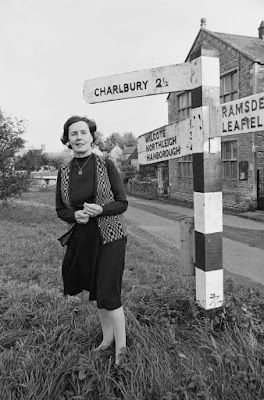Excellent Women by Barbara Pym - 1952 - A Novel - with an introduction by A. N. Wilson - 225 pages
“I suppose an unmarried woman just over 30, who lives alone and has no apparent ties, must expect to find herself involved or interested in other people’s business,” Miss Lathbury goes on, “and if she is a clergyman’s daughter then one might really say that there is no hope for her.” Mildred Lathbury - from Excellent Women, regarded as Barbara Pym’s best novel.
Barbara Pym
Born - June 13, 1913 - Oswestry, England
Died - January 11, 1980 - Oxford, England
Barbara Pym is among the best chroniclers of a now lost, maybe lost when she was writing, world of curates, vicars and women whose lives are bound up the social world of post World War Two England, with rationing, the return of service men and endless meeting for tea. No one has children out of wedlock, of course. Many have small “private incomes”.
“Excellent Women” is a tag attached to unmarried women who preform household
duties for unmarried Vicars and Curates.
Knowing The difference betwen a Vicar and a Curate is important in world of Excellent Women. A vicar is a priest of the Church of England who receives a stipend. A curate is his assistant, often in time to become a Vicar. Central to the novel, both can and are expected to marry. A Vicar’s wife or Widow is a high status person. An unmarried Vicar was a figure of great interest. First there is the quiet question of why he is unmarried and secondly who among the Ladies would be a good match.
Vicars set the tone of the community but we do meet nonbelievers and even more shocking Roman Catholics.
Having tea with someone is part of the glue of society. “Tea” appears 167 times in Excellent Women. References to gray comes
up 27 times. Many food stuffs are still rationed. People serve “meat” of an unidentifiable sort.
Housing is in short supply, exacerbated by the return of men from the service. As the novel opens, a married woman is moving into a flat. Mildred is thrown into a bit of a tizzy when she sees the woman in town with another man. There are numerous literary references, all squarely within the lending library scope. A society for amateur anthropology students plays an important part.
Mildred does enter into a relationship of sorts with one Everard Bone, she starts working on the index for his forthcoming book.
There are several subplots involving romances. In this world women are helpers waiting for men to explain things to them.
I enjoyed this book quite a bit. It looks like she has six more novels and I hope eventually to read through them.
If you like Jane Austen you will be happy with Excellent Women, if you don’t you probably will find her work a bit too gray







No comments:
Post a Comment